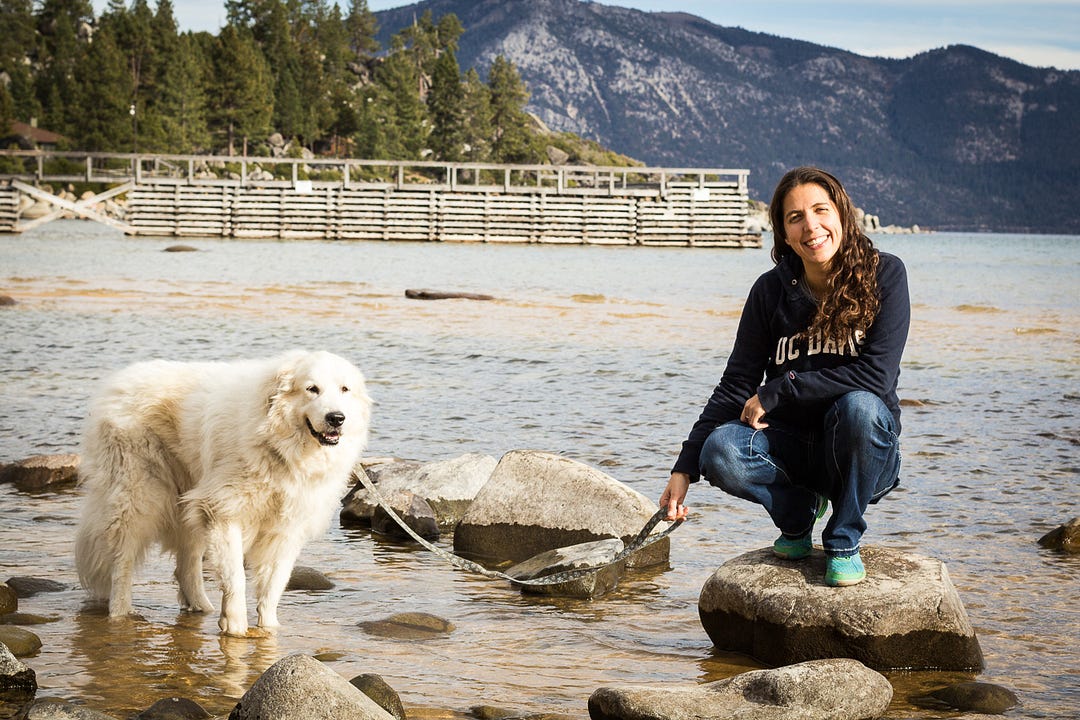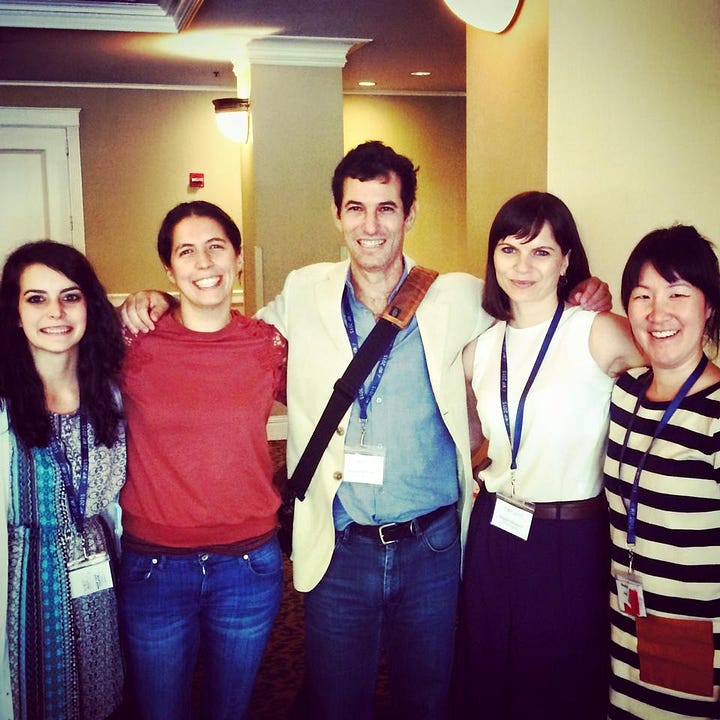
(This post was originally posted to the Collabra blog. Follow @CollabraOA on Medium here.)
Collabra is fortunate enough to have an impressive roster of senior editors in Life & Biomedical Sciences, Ecology & Environmental Science, and Social & Behavioral Sciences. We’ll be profiling each of the senior editors in the coming months to give you an idea of their work and research, as well as what inspired them to be part of Collabra. Next up: Simine Vazire, PhD, Senior Editor, Social and Behavioral Sciences.
Things are not always what they seem.
Take Senior Editor Simine Vazire, for instance, who studies this phenomenon as it relates to self-perception and how we’re perceived by others. In the academic world, the notion that “age equals wisdom” is professional currency, built up year after year via the standard benchmarks associated with being a research professor. Growing a reputational nest-egg simply takes time. But sometimes, careening out of left field, we get Gladwellian outliers. And Simine, though she might genuinely demur on this point, is one of them. At the age of 35, a time when many PhDs are considered academic fledglings, she already has an astounding number of accolades, professional honors, fellowships, invited talks, influential positions on a host of journals and editorial boards (beyond Collabra), and a rich cache of breakthrough research to bolster her prestige and credibility. The CV goes on. But outwardly, in appearance and demeanor, she is indiscernible from the grad students who populate her Personality and Self-Knowledge Lab at the University of California, Davis, right down to her dressed-down style and furry sidekick, Bear the dog. As she puts it, and simply, “Things are not always black and white.”

Swing this lens in a wide arc away from her, across her field of study, and you’ll find her scientific vantage point, the thing that absolutely fascinates her: the grey areas — the schisms that occur in research reporting and methodology, in human bias, and how it all plays out in actions taken, especially when it comes to producing replicable research. She is so interested in this issue, in fact, that she writes a regular blog about it, and while she might not consider her posts poetic, she writes in an e.e. cummings style. just much wittier.
Collabra caught up with Simine recently on the heels of new transparency and openness publishing guidelines that were recently introduced in Science,of which she was one of 30 coauthors, focusing on these questions of reproducibility. Though the guidelines have been in development since 2014, the timing is uncanny, given several recent high-profile retractions in the journals publishing world due to this very issue.
Our Q&A starts with her beginnings:
- What inspired you to pursue a career in Social Psychology?
“I’ve always been fascinated by people. I’m a bit of a wallflower, so I like to watch people, and I’ve basically figured out how to make a living out of it. I especially like observing people and forming my own impression of them and then finding out how they see themselves. The discrepancies can be fascinating. There are people who have much more glowing views of themselves than others have of them, and there are also people who don’t seem to have a clue how great they are. Both of these phenomena fascinate me, and the goal of my research is to try to measure what people are actually like, how they see themselves, how they’re seen by others, and why those three things don’t always line up.”
2. So, how would someone who knows you describe you, and do you agree with them?
“Haha, I knew you were going to ask that! Well, my favorite item on any personality questionnaire also happens to be the one I identify with most: ‘Is critical, skeptical, not easily impressed,’ and I think my friends would agree that this describes me pretty well. I think they would also say that I’m quiet, calm, and perhaps a little too reasonable, so I should probably start doing more unreasonable things in life!”
3. What drives you to engage in the work you do every day as a scientist and teacher?

“I’m pretty passionate about the questions I study, especially trying to understand why people sometimes have blind spots in their self-views, but I think I’m even more passionate about research methods. Maybe it’s because psychology is relatively young, but I’m amazed at the speed of progress I’ve seen in my fifteen-year career already. Both the development of new tools to collect data — like web questionnaires, smartphones, big data — and new tools (or the rediscovery of old tools) to analyze data have been amazing to witness. Things like multilevel modeling, structural equation modeling, Bayesian statistics, R . . . I also love teaching research methods, because it’s teaching people how to collect and evaluate empirical evidence. I think being able to take burning questions people have about human behavior, emotions, and relationships, and study those questions empirically, is an incredible development in human innovation.”
4. Can you share a particularly memorable experience or breakthrough in your research?
“I remember when my graduate school friend and colleague, Matthias Mehl, was developing the Electronically Activated Recorder (EAR) to study people’s naturalistic language use, and I realized it would be an excellent tool to study self-knowledge. You could use the EAR to ‘spy’ on people (with their consent, of course) and compare what they say they’re like to how they actually behave in their real life, not just in an artificial lab environment. Seeing how the right methodological innovation could open the door to studying questions that were almost impossible to study before was exhilarating, and it fueled my interest not only in self-knowledge, but especially in research methods. It made me realize how much the quality of our answers to research questions depends on the quality of the methods we have available.”
5. What do you think is the greatest challenge or concern in your field today?
“Replicability. That’s a broad word, and it encompasses all kinds of things, but mainly I’m concerned that the research methods we’ve been using lead to a much higher rate of false positive findings and inflated effect sizes than we would like. We can address this by running more rigorous studies (with more statistical power/precision) and doing our data analyses in a more thoughtful manner — avoiding p-hacking, preregistering when possible, more honestly reporting what analyses we ran and all the results we found.”
“We wanted to come up with a more universal set of standards that are both flexible and rigorous.”
6. How do these concerns play into the new Guidelines for Transparency and Openness Promotion (TOP) that you helped coauthor for journal publishing, that were introduced in Science this past June?
“First, these are recommendations for best practices, not mandates. Each society and/or journal has their own set of guidelines, but we thought there must be common ground. We wanted to come up with a more universal set of standards that are both flexible and rigorous. As an editor at several journals in the field, I had experience with many of the issues that we tackled in the TOP guidelines. A big issue in the field of psychology research is disclosing flexibility in these analyses. More often than not, researchers aren’t intentionally skewing results. The problem is that sometimes, well-meaning people, because of the pressure to publish and sometimes even direct pressure from editors and reviewers, gloss over things that are inconsistent with their findings and focus only on what’s consistent. This becomes even more of an issue in biomedical research because the incentives are so high. It’s a pretty big problem in psychology, too. And probably other social sciences. Ultimately, how much is at stake for finding what you want to find? It’s often a subconscious bias. Plus, especially in psychology, you’re often dealing with small samples, so results bounce around a lot. That makes replication more challenging, even when we try to correct against some of these biases. Then there’s the media. If they find the research sexy, there’s the tendency to simplify, to turn the findings into something more definitive than they really are. It’s challenging!”
7. You write quite a bit about these things in your blog. What was the inspiration for the title, “Sometimes I’m Wrong: Truth and Error in Research and In Life”?
“I like playing with things that are ambiguous and nuanced, especially countering the idea that things are black and white. Really, the number one reason I began writing it is because of the lack of women’s voices in the discussion about replicability. I didn’t know many other women who were visible, writing about it. But I’m not an expert, no more than the next person. Hence the title. I don’t have anything original to say. But the stuff we’re all reading and thinking about is worth discussing, so I write about it. That said, my worst nightmare is that someone will think I’m an expert, and I’m not.”
8. Okay, on a lighter note, do you otherwise have a secret super power or talent you’re willing to share?
“Haha! Not really. I am remarkably untalented. I like to dabble. I’ve been mediocre (or worse) at the following sports/hobbies: basketball, tennis, badminton, wrestling, volleyball, track, ultimate frisbee, trumpet, french horn, baritone, banjo, and pottery. Wait, actually, I’ve perfected the art of microwaving a Trader Joe’s burrito — wrap it in a paper towel, place it on a plate, microwave for a minute on each side, and voila. Dinner. I hate cooking more than almost anything else on earth. The whole time I’m cooking, I’m thinking, ‘You know, you could have something 80 percent as good in less than 5 minutes, so what’s the point of cooking.’”
9. And what attracted you to Collabra? Other than no cooking skills required?
“I like the fact that it’s run by a university press rather than a for-profit publisher. I also really like the team of people at UC Press who are running it — their vision for the journal and their genuine interest in science. I like the fact that it’s open access, but I also have some questions about how well that will work in my field — many of us don’t have large grants that can cover APCs. I like that the people behind Collabra acknowledge that we don’t yet have all the answers about how to make this format work for everyone, and they’re trying out different solutions, such as having a fund to cover APCs for authors who lack other resources.”
10. This brings us to our last question: what kind of impact do you hope to have as a Senior Editor for Collabra?
“Mostly, I hope to spread the word to other researchers and get them involved in Collabra. Researchers give away so much of their time and expertise to journals (both by choosing where to publish our work and by reviewing for free), and I think it would be good for us to reflect on who we want to give that time to, and what kind of journal/publishing model we want to support. I think Collabra is a great candidate for that. There’s flexibility. It’s not black and white.”
— Merrik Bush-Pirkle, Collabra

